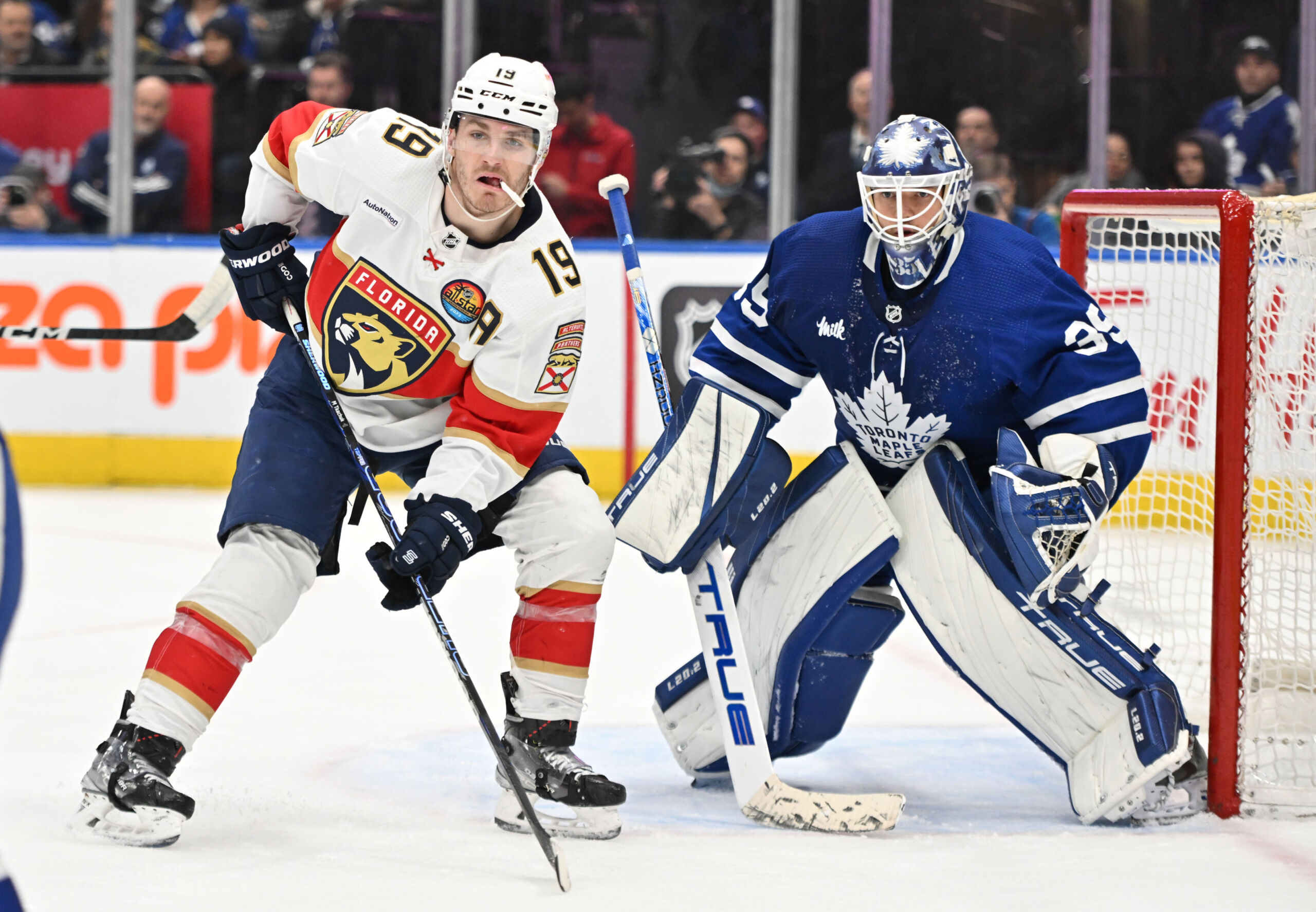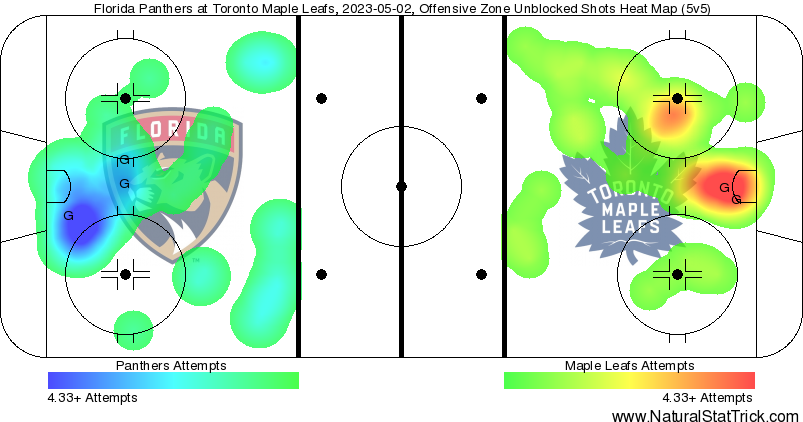For years now, the prevailing thought was that if the Maple Leafs could just get over the hump of winning in the first round, the pressure would be off and they would ride the wave from there.
They certainly looked like the pressure was off and played a loose, open style of hockey that played right into Florida’s hands and ultimately resulted in a 1-0 series lead for the Panthers.
Sergei Bobrovsky was excellent. The Panthers scored four goals, and while the Leafs did make some pushes and some will hang their hats on the team creating some scoring chances, it was ultimately a game that left a lot to be desired.
Your game in 10:
1. Every playoff series brings different challenges. Tampa was a veteran team that played a suffocating brand of hockey through the neutral zone and made the Leafs work for everything they got. The Florida Panthers are a young team and play a wide-open style of hockey.
We talked in the series preview about how the Panthers send two guys in deep and run a three-line attack pushing for offense. They have one good defense pairing plus Brandon Montour. It’s a free-flowing attack with a wide-open neutral zone from a team that is all too happy to trade chances and play a high-event game.
Conversely, the Leafs‘ formula for success throughout the season and even against Tampa Bay was a tight defensive team that played a compact style of hockey, moving up the ice as a five-man unit, executing lots of short passes, creating a safe environment for their goalies, and winning on special teams.
The Leafs finished ninth in goals per game and seventh in goals against per game. They didn’t do this playing wide-open hockey, and while fans and pundits fawned over some high-event hockey with lots of action for most of the first two periods, the reality is that this is not who the Leafs are nor is it what makes them successful.
2. The tone was set early on in this game as the teams traded chances. A few shifts into the game, Alexsander Barkov broke in on a mini 2v1 followed by Auston Matthews blowing the zone and breaking in all alone. Matthews actually beat Bobrovsky, but Bob was a bit lucky as the puck hit his stick.
There were a few other scoring chances early, including a Brandon Montour shot from the top of the circle and a John Tavares shot off the rush. It was a furious pace, and it eventually led to a Sam Bennett penalty as he flew in and leveled David Kampf. It’s the exact type of thing we expected from the team that led the league in minor penalties.
The Leafs buzzed on the early power play, getting a number of tip chances in the slot — notably from Matthews, a Ryan O’Reilly tip, and a 2v1 rush with Alex Kerfoot after the power play, which led to another power play where the Leafs again created looks.
The chances were there, and if they keep creating like this, they are bound to score. In the context of this game, the Leafs went to two early power plays and didn’t convert. That hurts.
3. To start Game 1 last series, there were some strange decisions early as the Leafs placed Ryan O’Reilly on the second line chasing matchups and an Alex Kerfoot – Noel Acciari – Calle Jarnkrok third line that went about as well as you would expect (which is to say not well at all).
To start this series, the strange decision was running the John Tavares-led line against the Sam Bennett – Matthew Tkachuk line. Presumably, the logic was that Mitch Marner was matched up on Tkachuk’s side and Calle Jarnkrok — who is a solid defensive winger — was on the other, but Tavares is not exactly a defensive center nor is he fleet of foot.
The Tkachuk line dominated them and opened the scoring in this one. Tavares and Mark Giordano lost a battle behind the net as Bennett came out with the puck and got it to Tkachuk, who walked out from the corner. Marner sort of half-heartedly waved his stick at him with one hand, which was easy for Tkachuk to just step around, walk in, and shoot. Cousins whacked in the rebound as Jake McCabe didn’t tie him up well enough.
In the second period, the Leafs started using Auston Matthews against this line, and it went much better. I just don’t know why the coaching staff thought this would be a good idea at all in the first place.
4. Against Tampa Bay in Game 6, Matthew Knies got beat on the wall in his own end for a goal against as the puck went through him and to his point man, who got a free shot on net off leading to a rebound that Steven Stamkos slammed home.
We’ve noted a few times now that Knies has been a breath of fresh air in the offensive zone and has struggled on the wall in the defensive zone, but overall, he has been a net positive. On this goal, he got burned.
The initial read on going to the puck was a tough decision. He would have had to anticipate it perfectly, but he didn’t and backed off. The problem was that he didn’t cut off the pass to the point and was then out of position. He tried to overcompensate by going down to block the shot, but he actually just deflected the point shot, Sam Bennett tipped the tip, and Ilya Samsonov had little chance on the goal.
5. I have to give Sheldon Keefe credit for sticking with Matthew Knies right after the goal. It would have been easy to pull him off and potentially even keep the rest of the line out there, but he gave him a chance to get a good shift in after the goal against and Knies ended up getting the goal back altogether.
It was a quick play. The Leafs won the faceoff and Morgan Rielly banked it off the wall to Knies, who chipped it up to Auston Matthews. From there, Matthews made a great play to grab the puck, use his body to protect it, enter the zone, and then find Knies with a backhand pass as the trailer.
The main reason that sequence was such a mess for Florida is that Sam Bennett got kicked out of the faceoff circle, so it was Nick Cousins who lost it and then checked Matthews as he gained the zone. It was Bennett not supporting the backside, which is where Knies picked up the puck as the trailer, walked in untouched, froze Bobrovsky with a hesitation move, temporarily bobbled it, got it back under control, and slammed it home on the backhand into an empty net.
MATTY KNIES ARE YOU KIDDING!! 🤢 pic.twitter.com/NLPwFSoM5Q
— Toronto Maple Leafs (@MapleLeafs) May 3, 2023
6. The crowd was back into it after the goal as the Leafs pushed to tie. Eventually, they did level the score as Michael Bunting scored on a nice finish all alone in front.
Timothy Liljegren started the play by denying Florida at the Leafs blue line, helping Toronto get the puck back. The Leafs caught Florida on a line change for a quick 3v2 where we could see some of the vulnerabilities on Florida’s defense.
There was no reason for the play to be that easy. All Ryan O’Reilly did was dish the puck to Calle Jarnkrok on the wing and Radko Gudas stepped up for pretty well no reason to commit to ROR, leaving an easy pass for Jarnkrok to make to the backdoor. Jarnkrok hit Bunting in stride and he pulled it backhand for a nice finish.
SCARBOROUGH STAND UP!!!! 🗣 pic.twitter.com/miFHAf2v25
— Toronto Maple Leafs (@MapleLeafs) May 3, 2023
Bunting was really good in Game 6 and scored a nice goal in this game. He’s playing with ROR, so they aren’t exactly banishing him down the lineup, but he played only 14:24 in this game, which was sixth among Leafs forwards. He was eighth among Leafs forwards in his first game back.
They need Bunting rolling, but he also needs a bit more opportunity than they are currently giving him if he’s going to be at his best.
7. After the Leafs tied it, the arena was predictably bumping and it clearly went to the Leafs’ legs. Sometimes that energy is channeled the wrong way, though.
At 2-2, Jake McCabe made a nice play to step up in the neutral zone and blow up Anthony Duclair with a nice hit, causing a turnover and a 3v2. However, McCabe skated up the ice to join the rush that he was clearly too far behind to involve himself in. When the play was broken up, McCabe kept skating forward and was completely out of position as the puck transitioned the other way.
As the puck went up the wall, TJ Brodie found himself in a 50/50 race for it with Carter Verhaeghe and did the worst thing you can really do in that situation: sort of half make a play on the puck. Either you go in and make a strong play, or you pull back entirely. Instead, he skated over and waved at the puck with one hand.
Brodie actually did deflect the original pass with his skate, but it went right back to Duclair, who just passed it again to Verhaeghe, who went in on a breakaway and snapped it home.
Ryan O’Reilly was at the end of his shift and had no gas left in the tank to try to catch him. He stopped skating slightly when the puck hit Brodie’s skate in the first place, and while I don’t think he would have caught him regardless, he could have made it more difficult had he not slowed up.
8. For as much as Florida played a wide-open style of hockey through two periods, with a lead going into the third, they actually really tightened the game up. The Leafs tried stretching the zone a bit with wingers up at the far blue line at times and blowing the zone a bit more than we are used to seeing from them. The Florida defensemen stood right on top of them.
Even on regular breakouts with wingers on the half-wall, the defensemen pinched in and applied pressure. At one point, Morgan Rielly had the puck below the goal line and was staring at Matthew Knies, who stood there as Aaron Ekblad crept in from the blue line. Recognizing what was happening, Rielly just put it off the glass and out.
There were a number of times in the third period when the Leafs defensemen had the puck and there were no forwards open or getting open to give them clean outlet options. The Leafs went into the third period down a goal, and at 5v5, Florida generated 16 shot attempts to the Leafs’ eight. The expected goals were basically the same (.79 for the Leafs vs. .76 for Florida). When the Panthers needed him to be good, Sergei Bobrovsky stood tall.
9. The Leafs stepped up the aggression as they attempted to push to tie the game, leading to Jake McCabe pinching down the wall, tripping Matthew Tkachuk on a breakout, and Florida proceeding to go down the ice and set up a 6v5 attack like a power play.
The Leafs were completely discombobulated. For some reason, William Nylander was tied up with Marc Staal in front of the Leafs’ net while Florida set up a triangle up top that Ryan O’Reilly and Noel Acciari tried to defend. It led to a one-timer by Montour that deflected off of ROR and in.
There was some traffic in front, but it was tough to figure out what exactly Ilya Samsonov was doing on the goal. He was swimming around the crease as the puck originally went across the ice to Tkachuk on the half-wall and Samsonov slid over and bit hard, losing his net a bit in the process.
At the end of the first period, Samsonov made some great saves to keep the Leafs in the game, but it was a fairly ordinary performance from him overall. With Bobrovsky at the other end standing tall, it was a tough look for the Leafs.
Even with time left, the game felt over after the Montour tally. It was a deflating goal. The Leafs did make a small push and came close a few times, but it was too tall a hill to climb.
10. This felt like a game that got away from the Leafs, but it should also serve as a bit of a wake-up call. They can’t get sucked into playing pond hockey with the Panthers. This was playing to their level. It’s not Leafs hockey, and it’s not the Leafs dictating the style of play. They played loose.
It didn’t even feel like a playoff game other than the fact that the crowd was super into it. Mitch Marner played over 25 minutes. Auston Matthews played over 24. John Tavares was over 21, around three minutes more than Ryan O’Reilly. Those are ice time totals that make you think of playoffs past.
The Panthers were swept in round two last year by the Lightning because the Lightning actually checked and didn’t let Florida play like this. The Leafs checked hard in the first round, and in the closeout Game 6, they leaned on checkers to actually check — Noel Acciari played 18:31, and David Kampf played 16:25.
Acciari played just over 11 minutes in this game and Kampf played just over 10. Instead of trying to beat Florida at their game, the Leafs have to impose their own. That doesn’t mean those guys should be receiving huge minutes, but they are effective grinders that play to the Leafs’ identity. They aren’t footnotes on this team.
Much like round one, Mark Giordano struggled. Everyone in the market jumped on Justin Holl — and yes, he struggled, too — but his partner was poor as well. Because he was playing with Holl, it was masked over. He played just over 15 minutes and is their second power-play unit quarterback. It’s fair to wonder if Giordano is wearing it down and whether the approach should change now (11-7? Healthy scratch?). Zach Aston-Reese played just over six minutes and is an easy option to take out of the lineup.
Florida has three good lines, and the Leafs botched the matchups in Game 1. They started to figure it out as things went along, but ultimately, they ended up chasing the game. They will need to adjust and impose their style heading into Game 2.



































![New Leaf Anthony Stolarz on the opportunity in Toronto: “In Florida, I knew my role as a backup… Now, [Joseph Woll] and I are competing for starts… As a goalie, that’s all you can ask for” Anthony Stolarz, Stanley Cup win, now Maple Leaf](https://mapleleafshotstove.com/wp-content/uploads/2024/07/anthony-stolarz-sc-100x70.jpg)
